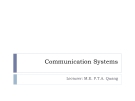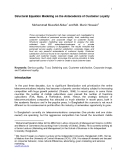
Mobile telecommunications services
-
A bit (binary digit) is the smallest unit of information • N = 2n where N is the number of representations and n is the number of bits (ex. ASCII, Unicode, PCM code etc.) • Data communications transfer information using codes that are transmitted as signals (either analog or digital) • In general, analog lines provide a slow service that contains high error rates.
 59p
59p  trungkiendt9
trungkiendt9
 24-04-2011
24-04-2011
 100
100
 18
18
 Download
Download
-
Lecture Electronic commerce - Chapter 9: Mobile Computing and Commerce and Pervasive learning objectives: Describe the mobile computing environment that supports m-commerce (devices, software, services). Describe the four major types of wireless telecommunications networks. Define mobile commerce and understand its relationship to e-commerce. Discuss the value-added attributes, benefits, and fundamental drivers of m-commerce. Discuss m-commerce applications in finance, shopping, advertising, and provision of content. Describe the application of m-commerce within organizations.
 53p
53p  caphesuadathemtac
caphesuadathemtac
 09-11-2021
09-11-2021
 21
21
 3
3
 Download
Download
-
Study on customer satisfication in mobile telecommunications services in Việt Nam: Central provinces
The objectives of the study are: To collect and select theory related to customer satisfaction; to determine effects of different factors on customer satisfaction usingmobile telecomunication services; to determine effects of customer satisfaction on customer loyalty withmobile telecomunication services provided by three mobile network operators: Vinaphone, Mobifone and Viettel.
 26p
26p  change05
change05
 14-06-2016
14-06-2016
 46
46
 6
6
 Download
Download
-
The objective of the study: Analyze and evaluate the competitiveness of the state providing mobile communication services of a telecom company in Vietnam, comparing the strengths and weaknesses of the provision of services between the companies together and find out the problems to be solved in order to improve their competitiveness;...
 0p
0p  nguyenthiminh32
nguyenthiminh32
 12-07-2014
12-07-2014
 71
71
 7
7
 Download
Download
-
Communication Systems Lecturer: M.E. P.T.A. Quang .Contents Chapter 1: Introductory Concepts Chapter 2: QoS Chapter 3: Transmission and switching Chapter 4: Digital networks Chapter 5: Signaling Chapter 6: PSTN Chapter 7: VoIP Chapter 8: Mobile communication Chapter 9: Satellite communication Chapter 10: Fiber-optic communication .
 20p
20p  vanmanh1008
vanmanh1008
 24-06-2013
24-06-2013
 112
112
 7
7
 Download
Download
-
In the past three decades, due to significant liberalization and privatization the entire telecommunications industry has become a dynamic service industry subject to increasing competition with huge growth potential. (Graack, 1996). In recent years, in some Asian countries the number of mobile subscribers even passed the number of fixed-line subscribers (Fink, Matto, & Rathindran, 2003). Hence, the strategic behavior of telecommunications companies has attracted so much attention in recent years, both in the academic literature and in the popular press.
 20p
20p  quanghao1991
quanghao1991
 26-08-2012
26-08-2012
 90
90
 9
9
 Download
Download
-
Channel Assignment Problems (CAPs) occur in the design of cellular mobile telecommunication systems (Jordan, 1996; Katzela and Naghshineh, 1996; MacDonald, 1979); such systems typically divide the geographical region to be serviced into a set of cells, each containing a base station. The available radio frequency spectrum is divided into a set of disjoint channels; these must be assigned to the base stations to meet the expected demand of each cell and to avoid electromagnetic interference during calls....
 15p
15p  tienvovan
tienvovan
 11-09-2010
11-09-2010
 81
81
 6
6
 Download
Download
-
Mobile agent platforms and systems Advanced service provisioning allows for rapid, cost-effective service deployment. Modern mobile telecommunications evolve towards value-added, on-demand services in which the need for communication becomes frequent and ongoing, and the nature of the communication becomes more complex. The services of the future will be available ‘a la carte’, allowing subscribers to receive content and applications when they want it.
 10p
10p  huggoo
huggoo
 20-08-2010
20-08-2010
 74
74
 10
10
 Download
Download
CHỦ ĐỀ BẠN MUỐN TÌM





















